NORTH WALES COAST RAILWAY:NOTICE BOARD
Rheilffordd arfordir gogledd Cymru: Hysbysfwrdd
24 June 2016
Tweet
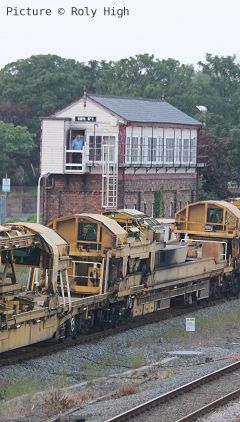
Tweets by @NWrail1
Contributions and comments are encouraged: see the Contributions Page
This list may be out of date if you are reading an archived issue. For full information visit our Calendar page.
July 2016
Sunday 24 July Railway Touring Company THE NORTH WALES COAST EXPRESS Liverpool-Holyhead (WCRC) Steam loco 45690 or 46100: Liverpool - Chester - Holyhead and return
Tuesday 26 July Railway Touring Company THE WELSH MOUNTAINEER Preston - Blaenau Ffestiniog . Steam loco 45305 or 48151: Preston - Chester - Blaenau Ffestiniog and return
August 2016
Sunday 21 August Railway Touring Company THE NORTH WALES COAST EXPRESS Crewe - Manchester - Holyhead (WCRC) Steam loco 45690 or 46115: Manchester - Chester - Holyhead and return
September 2016
Sunday 4 September Railway Touring Company THE NORTH WALES COAST EXPRESS Crewe - Manchester - Holyhead (WCRC) Steam loco 45690 or 46115: Manchester - Chester - Holyhead and return
Friday 30 September Great Western Society North West Branch. Steam in Black and White. Peter Spilsbury.
October 2016
Friday 28 October Great Western Society North West Branch. Railway Personnel. Paul Shackcloth.
November 2016
Friday 25 November Great Western Society North West Branch. GW Steam in S. Wales and S West. Alf Storey
December 2016
January 2017
Friday 27 January Great Western Society North West Branch. North of Preston Barrie Rushton
February 2017
Friday 24 February Great Western Society North West Branch. Group AGM
March 2017
Friday 31 March Great Western Society North West Branch. (To be announced)
April 2017
Friday 28 April Great Western Society North West Branch. (To be announced)
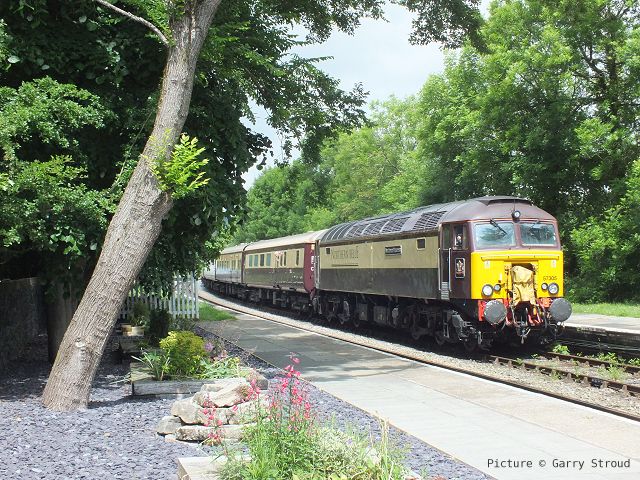
The 'Northern Belle' at North Llanrwst, 18 June (Garry Stroud).
This is an extra update: the next one will appear a day later than usual on the evening of Tuesday 28 July. For the exploits of the Flying Scotsman, see the 20 June issue.
Freight views
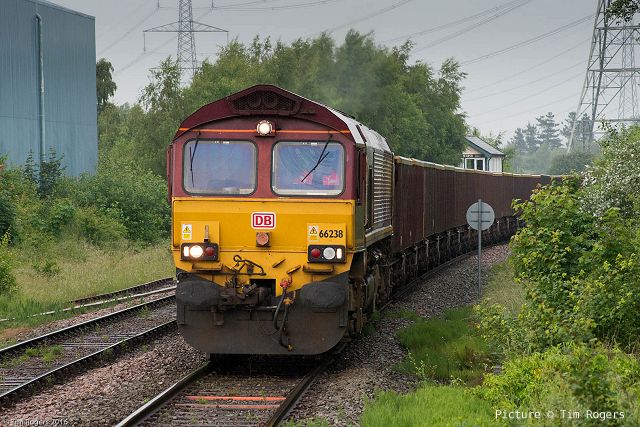
66 238 approaches Hawarden Bridge on 15 June with train 6E41, 16:56 Penyffordd Cement Sidings – Arpley Sidings. The MEA wagons are returning empty after bringing coal from Scotland to the cement works. Dee Marsh Junction signalbox is in the background. Picture by Tim Rogers.
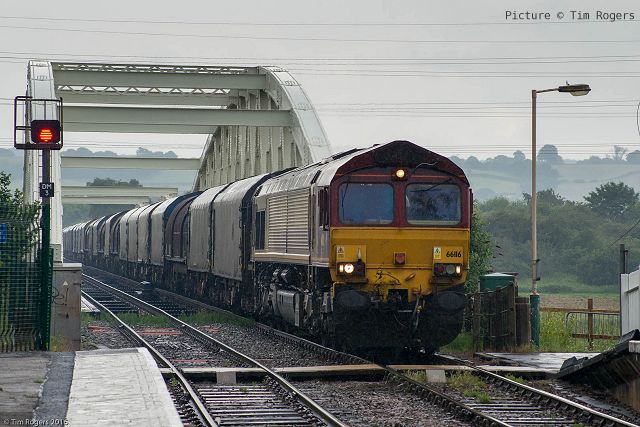
Hawarden Bridge station on 15 June: 66 116 crosses the Dee with 6M86 10:29 Margam – Dee Marsh, loaded with steel for coating at Shotton works (Tim Rogers). Dee Marsh Junction No.3 signal is of the latest style with a single head - an array of LEDs can show the different aspects as necessary.
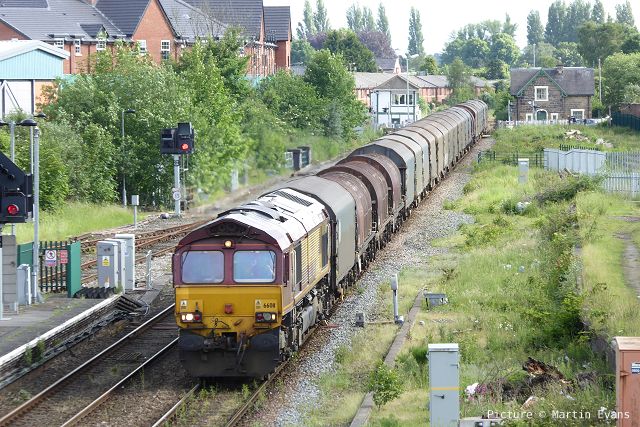
66 011 drifts into Wrexham General with train 6M86, of steel coil from Margam to Dee Marsh on 17 June at 17:30. Surprisingly this service ran every weekday from 14 to 18 June whereas recently it has been running only once or twice a week, with a morning service - 6M76 - taking precedence. Picture by Martin Evans.
Northern Belle
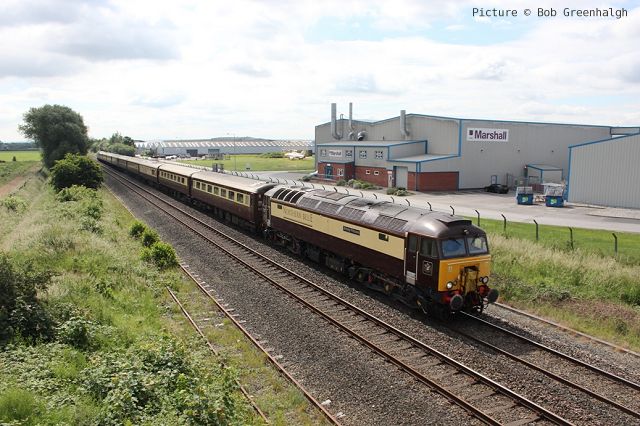
On 18 June the 'Northen Belle' luxury dining train ran from Coventry, calling at Birmingham International, Wolverhampton, Macclesfield, Manchester Victoria and Chester. Bob Greenhalgh photographed it at Beeches Farm, west of Chester (Bob Greenhalgh).
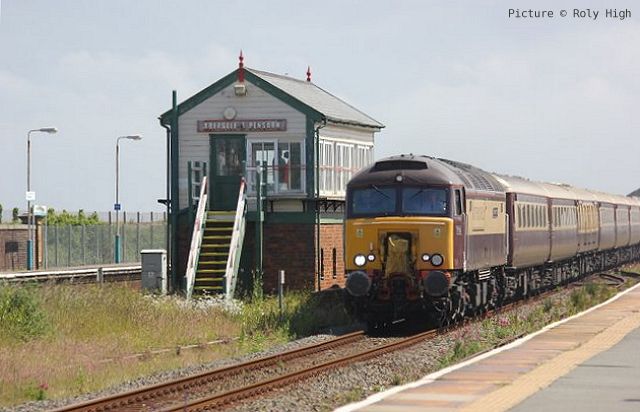
Abergele (Roly High). The DRS locos in charge were specially-liveried 57 312 Solway Princess and 57 305 Northern Princess.
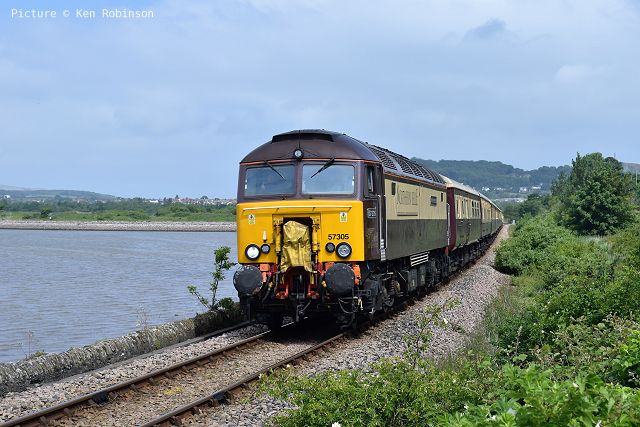
57 305 leading near Glan Conwy station after the reveresal at Llandudno Junction (Ken Robinson).
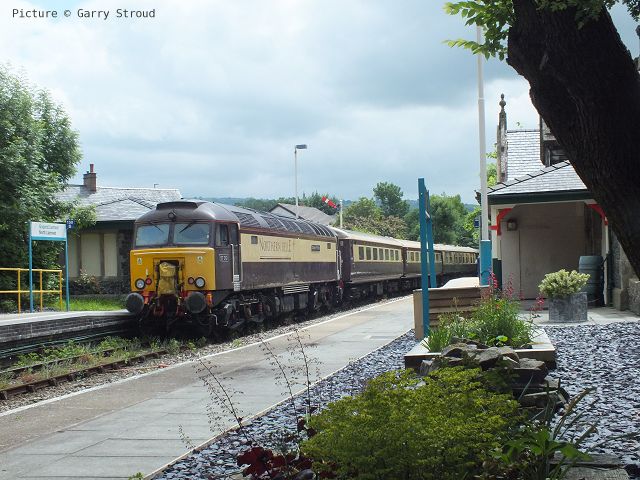
North Llanrwst where the train paised to allow the 11:35 Arriva Trains Wales service from Blaenau Ffestiniog to pass (Garry Stroud).
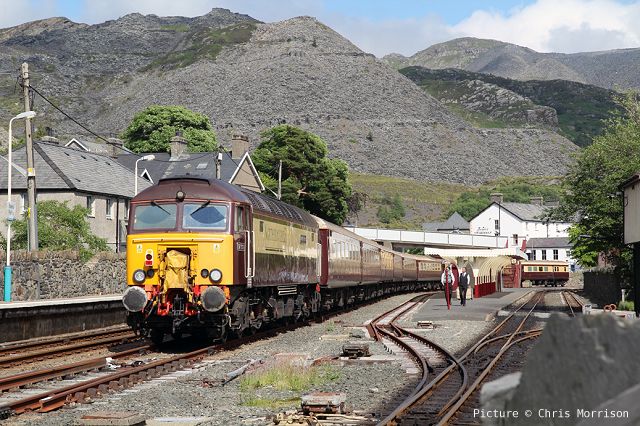
57 312 waits in the loop at Blaenau Ffestiniog with the Northern Belle stock, waiting to return to Coventry (Chris Morrison).
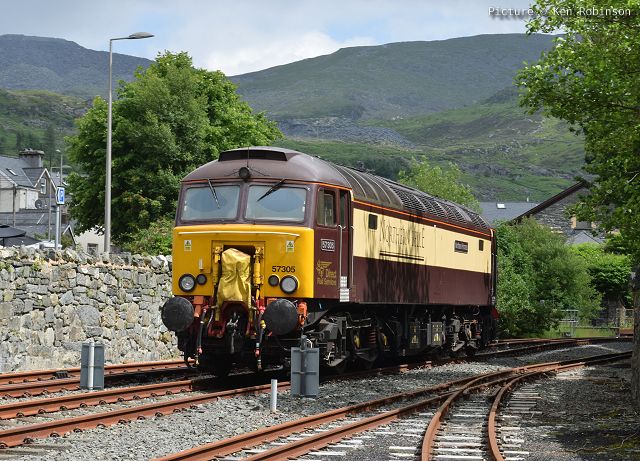
57 305 had to be detached from its train at Blaenau as due to the length of the train it fouled the foot-crossing used by Ffestiniog Railway passengers (Ken Robinson).
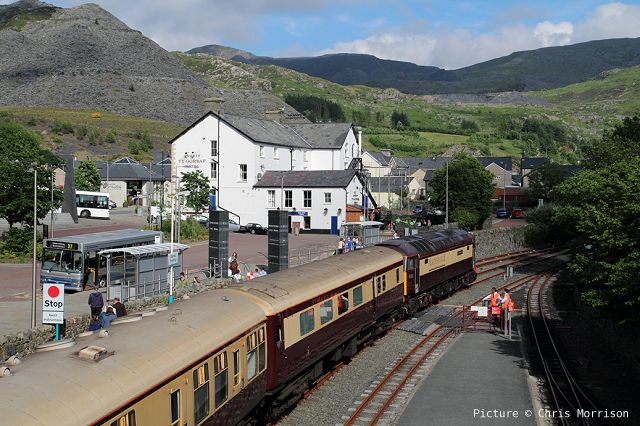
57 305 re-united with the train and waiting to return to Coventry (Chris Morrison).
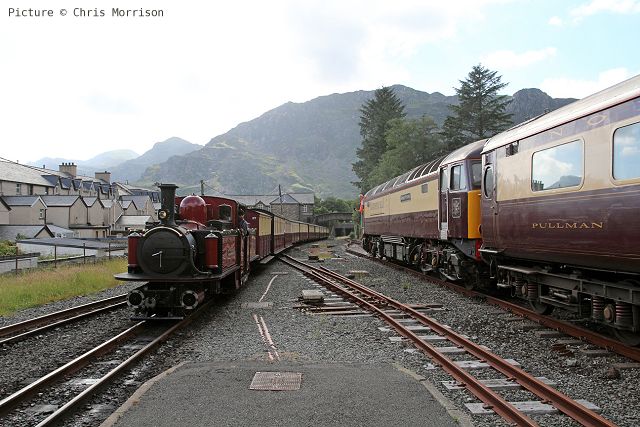
Ffestiniog Railway double Fairlie David LLoyd George arrives at Blaenau Ffestiniog with a train from Porthmadog (Chris Morrison).
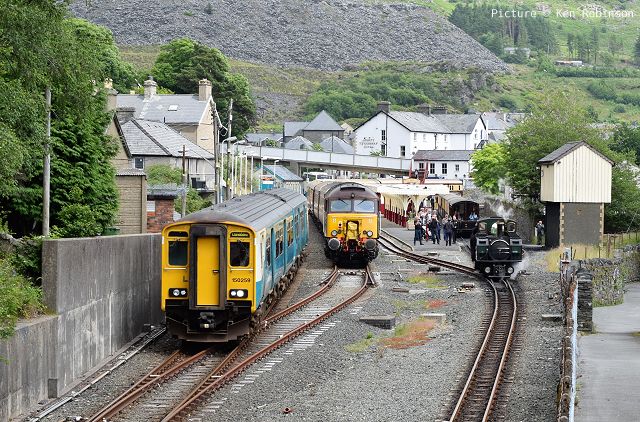
'Three in one' at Blaenau Ffestiniog - 150 259 leaving with 2D17, the 14:57 service to Llandudno, 57 312 at the head of the Belmond empty stock in the loop, and FR's Earl of Merioneth (Ken Robinson).
Halton Curve summer service - report by John Hobbs
In conjunction with The North Cheshire Rail Users' Group's efforts to re-open Halton Curve, Northern have kindly arranged for the extension of the 07:53 Chester to Runcorn (Main Line) to Liverpool South Parkway on Saturday 16 July. In addition it will make station calls as detailed below:
Chester 07:53, Helsby 08:02, Frodsham 08:06, Runcorn 08:17, Liverpool South Parkway 08:25
Hopefully we will see an hourly service in each direction provided over the line by the end of 2018. The Group's Halton Curve video shows the line as it was last year before extensive delayed routine maintenance opened up the line for photography.
An interesting ticket on which to undertake this journey is a "Off Peak" return £9.20 Chester to Warrington (Central) via Liverpool South Parkway which is valid on the return journey via Liverpool or via Crewe or directly from Warrington (Bank Quay) via Helsby to Chester.
Class 67 doings
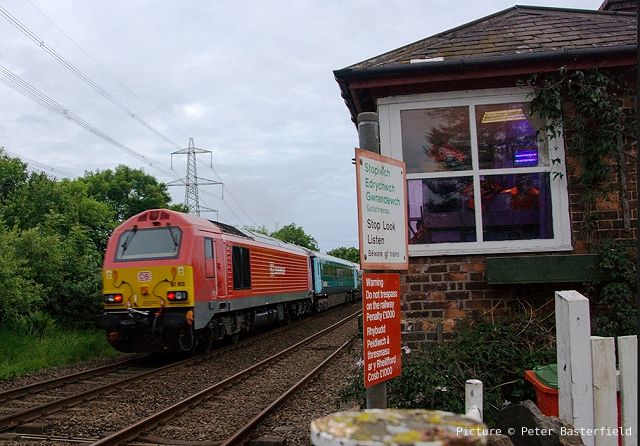
Llanfair PG with 67 013 propelling the evening Cardiff - Holyhead express on 14 June (Peter Basterfield). This may be the last loco to have received the 'Schenker' wording, as re-named 'DB Cargo UK' seem to prefer a simple DB logo.
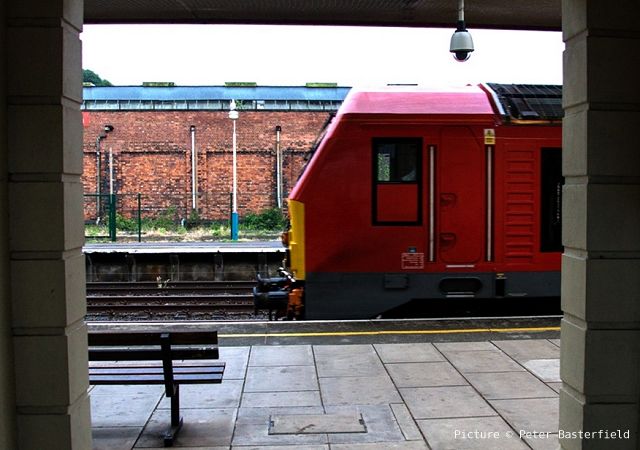
Peter Basterfield made a day trip to the 'Gardener's World' show at the Birmingham NEC, using the local-hauled express both ways, with a change at Shrewsbury. Above, 67 013 at Bangor in the morning ...
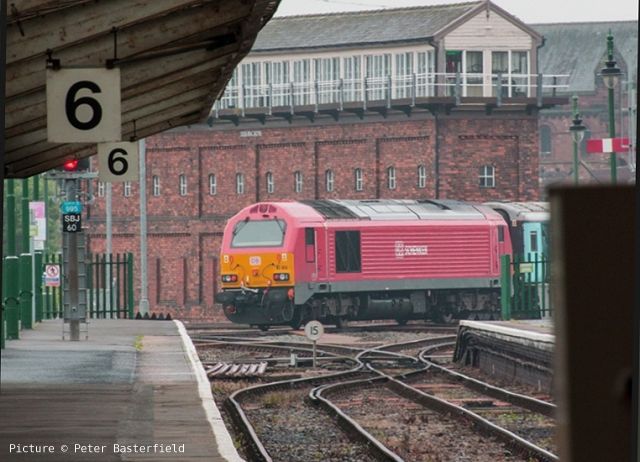
... contrasting with the veteran signalbox at Shrewsbury Severn Bridge Junction as the train departs for Cardiff ...
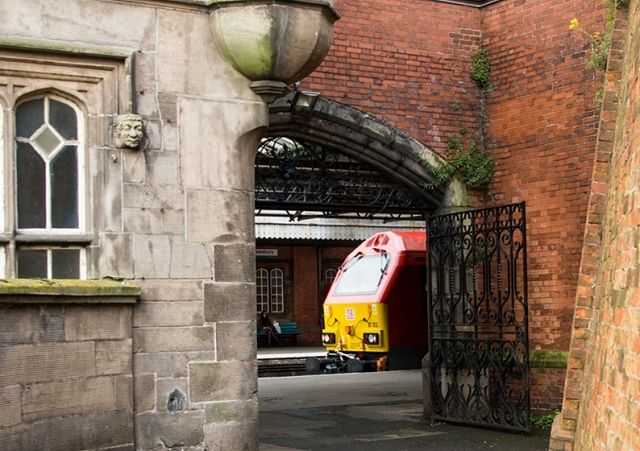
.... and the return arrives back in Shrewsbury's platform 3, seen through the entrance arch amid the station's intriguing architecture (Peter Basterfield) This loco worked southbound to Cardfiff on Friday 17 June, to be replaced by 67 002 for that evening's return to Holyhead.
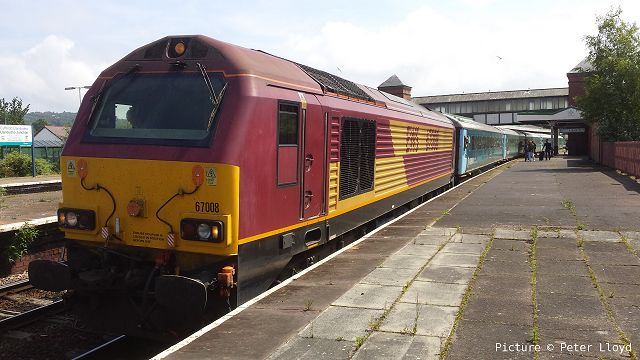
The other loco-hauled diagram: Train 1D34 09:50 Manchester Piccadilly - Holyhead at Llandudno Junction on 15 June with 67 008 (Peter Lloyd).
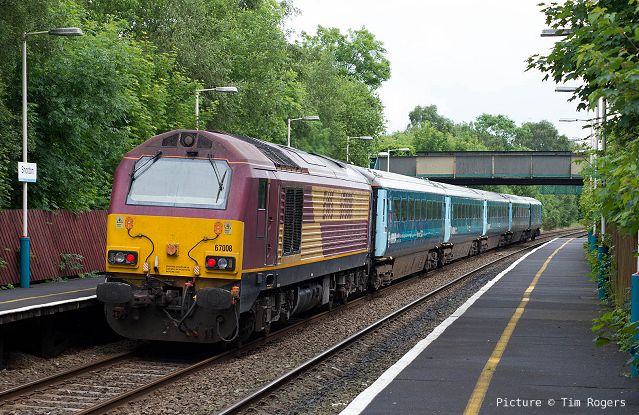
67 008 returns with 1H89 13:07 Holyhead to Manchester Piccadilly at Shotton on 15 June (Tim Rogers).
Replacements of this diagram by railcars on an erratic basis have continued, to the annoyance of photographers such as Mike Sheridan who reports on 10 June:
First we got caught in the worst downpour I have ever experienced in the UK made worse by the fact we were travelling on a very busy and now dangerous ' A55. When we got to Llandudno it was foggy - could be sea mist, but still very poor light for photographs. I haven't been to Llandudno station since the summer of 2000 when we had the evening Llandudno shunt so was a bit surprised to see it cut down to three platforms ... made worse by the realisation that Manchester trains used the worst possible platform for a good photograph. So anyway I decided to go to Deganwy station and waited patiently for the 67 to arrive....only it didn't.
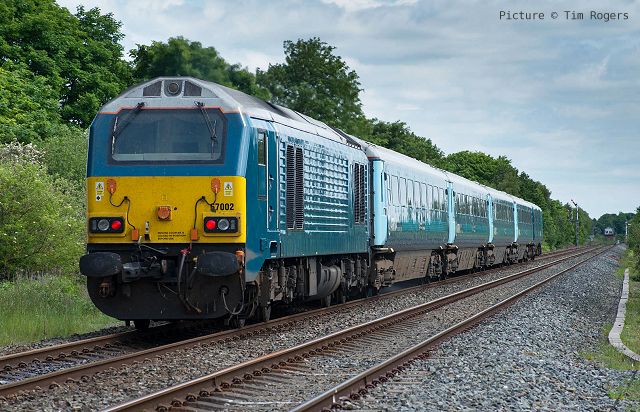
67 002 at Greenfield with the 13:07 Holyhead - Manchester, 1 June (Tim Rogers).
The High-output Tracklaying Train
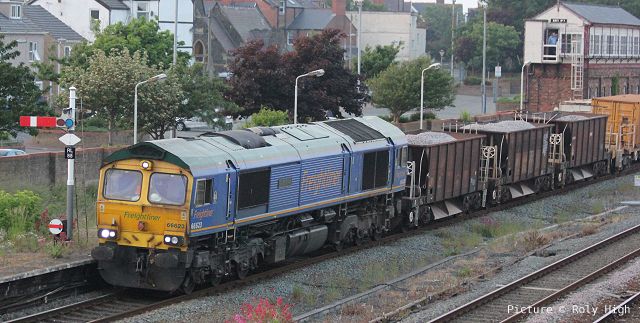
The Coast line has recently been treated to the nocturnal activities of one of Network Rail's High Output Trains, a remarkable attempt to bring mass-production techniques to track re-laying. Roly High was able to photograph it in the summer evening light on 8 June.
In the words of a useful article on the Rail Engineer website, it is:
... about 800 metres long and weighs up to 2500 tonnes. It can tear up old track, smooth off the ballast, place fresh concrete sleepers on it and then lay continuously welded rail into position, fastening the clips up neatly – all faster than you can walk.The train has a Class 66 loco each end, whose role is to deliver the train to and from the work site; in tracklaying mode, the train moves itself, although the loco at the ballast hopper end will be used to move wagons. Above, we see 66 623 Bill Bolsover and wagons of new ballast at the end of the train. The train itself is divied during operations.
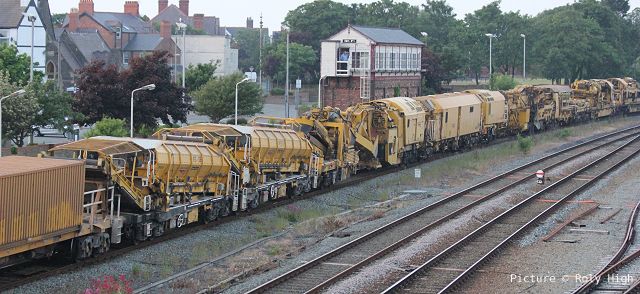
The special vehicles in the centre of the train are the 'clever' part, including a section which operatives walk along underneath the moving unit - hammering 'Pandrol' rail clips into place. The lengths of new rail have been delivered to the site in advance - old, rails and sleepers are removed by the machines and new sleepers and rails put in place as the train moves slowly but steadily along. The walking staff can pull emergency cord to apply the brakes if someone falls or there is a problem. The wagons with the sloping bodies carry ballast, and are connected together by a conveyor belt.
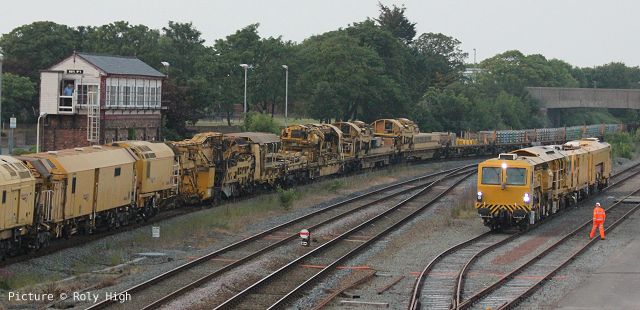
A pair of 'normal' track machines or on hand - a tamper and a ballast regulator which have a part to play. There is an excellent description of a night's work written by a Network Rail manager on the RMweb forum.
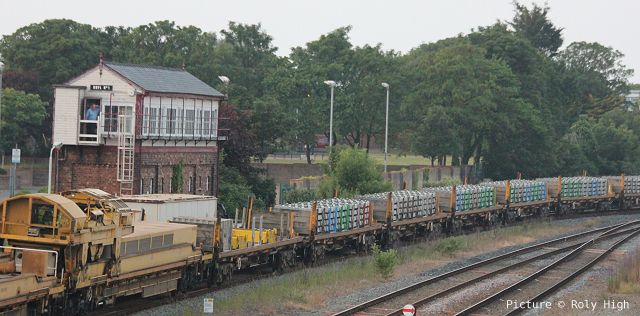
Wagon carrying sleepers make up the east end of the train. The gantry, with the curved top, collects the sleepers by running along the rails fitted to the sides of the wagons.
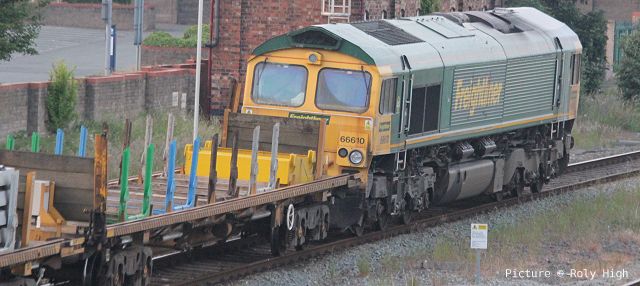
Finally 66 610. There is a YouTube video which gives an idea of the train in action.
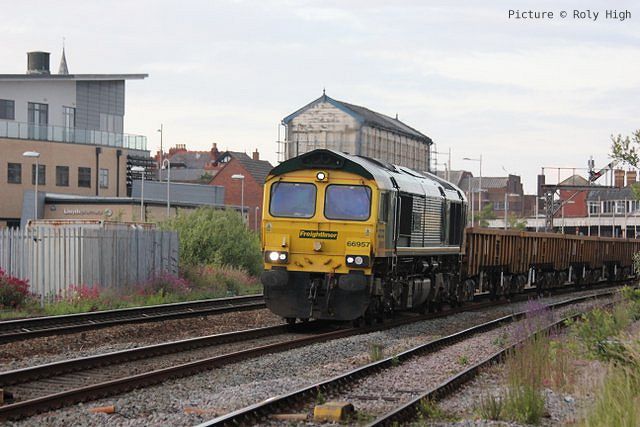
Conventional trains of ballast wagons also operate: this is 66 957 Stephenson Locomotive Society 1909-2009 passing Rhyl on 18 June....
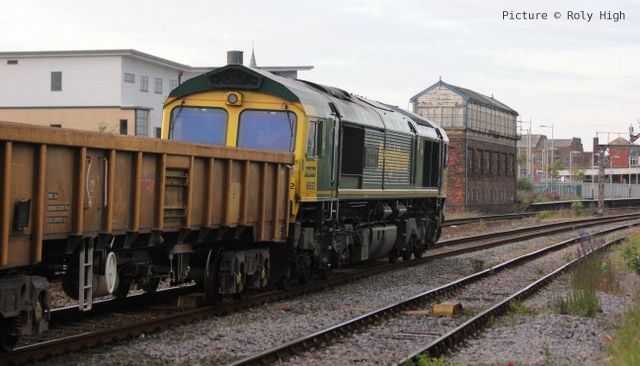
... and 66 592 Johnson Stevens Agencies on the rear.
Vale of Rheidol 40 years on - with Stephen Hughes
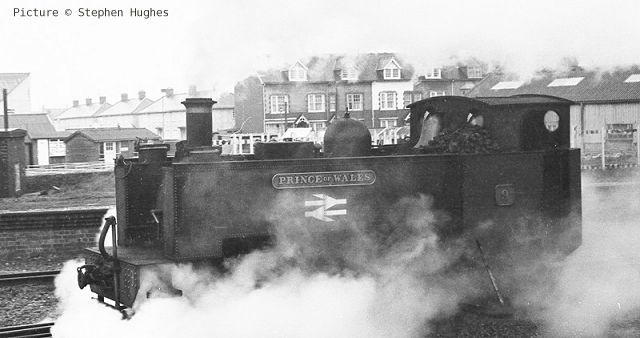
Forty years ago, during the first two weeks of June 1976, I was taking my finals at Aberystwyth University. That fact alone had absolutely nothing to do with railways, but as I was, at the time, renting a cottage a few miles from Devil's Bridge with friends and did not drive, I had to use public transport to travel into Aberystwyth and back if my exam timetable did not coincide with one of the car owners.
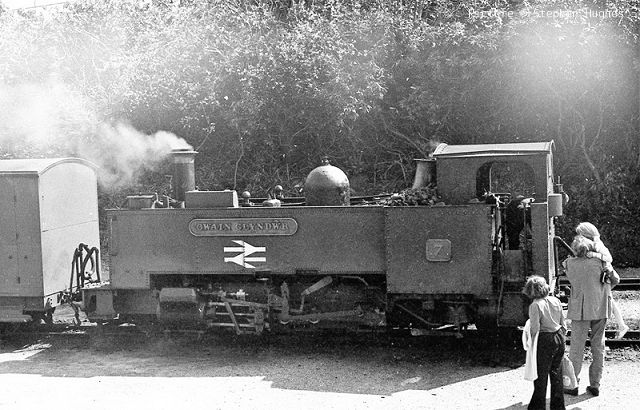
On two occasions I caught the bus which left around 08:00, but as the only bus in the opposite direction was at 17:30 I could either spend time in the library or catch the 14:00 train back up the valley. Naturally I chose the latter, and have since amused myself with the thought that I was probably the only student in the UK who could return home by steam! I recall after a gruelling three-hour exam it was a most relaxing (chillaxing in today's parlance, I suppose) experience.
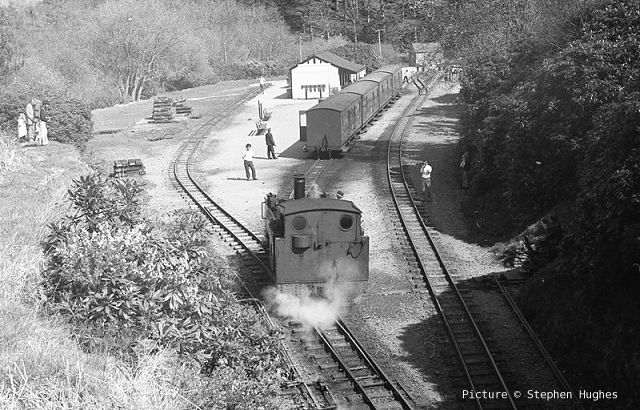
I have no recollection of which locomotive hauled the trains, and I did not take my recently-purchased bulky Zenit-E camera into the exam, but I have found a few photographs I took around that time of No. 7 'Owain Glyndwr' and No. 9 'Prince of Wales', both 'resplendent' in BR Blue.
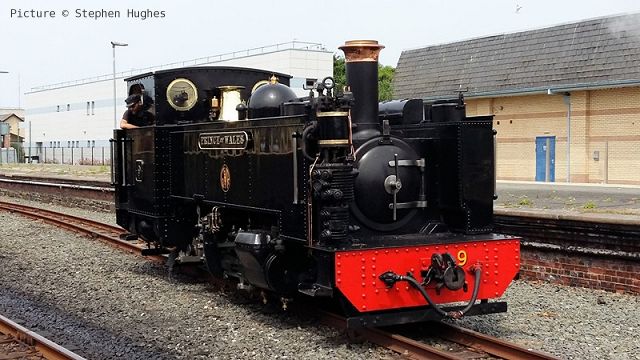
Fast forward to June 2016: looking to have a few days away somewhere in the motorhome, we chose Devil's Bridge as it has always been a special place for me since those University days. There is an excellent campsite there, and the unique Hafod Arms Hotel which in my later working life was a venue for many meetings. Of course, a return trip on the railway was essential, and we duly caught the 10:00 departure from Aberystwyth behind No. 9 'Prince of Wales'. Much has changed on and around the railway in those intervening years as is to be expected, but the beautiful panoramic views of the valley remain, and of course the sound of the engine working hard up the 1 in 50 climb.
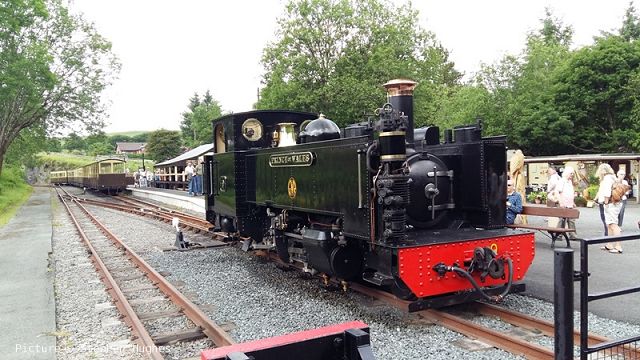
The train (seen above at Devil's Bridge) was well loaded for early in the season and crewed by friendly and enthusiastic staff. Considerable sums of money have been spent on improving the infrastructure, it certainly shows ... and of course we saw many Red Kites from the train, far more than there were in the area in 1976. Not only has the livery of the three VoR locos changed from the corporate BR blue, No. 9 was in a very smart GWR black (as seen in the photographs having arrived at Devil's Bridge and running round on its return to Aberystwyth) but the provision of the Westinghouse air pump in front of the off-side tank has considerably altered the aesthetic appearance - necessary because of the conversion of the entire stock from vacuum to air braking following the sale of the line by British Rail. A most enjoyable trip, evoking many pleasant memories of student days.
It's Quicker by Rail ...
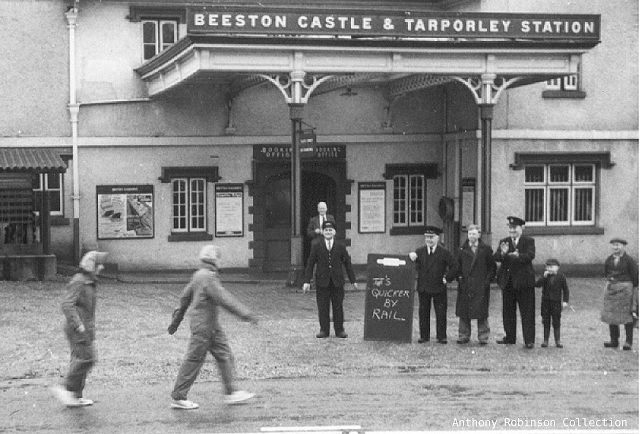
Tony Robinson sends us this fascinating picture, which he says 'might appeal to older readers', portraying Dr Barbara Moore (with companion) passing Beeston Castle station on her walk in 1960 from John O'Groats to Land's End. For younger readers who don't remember Cliff Michelmore and the 'Tonight' programme (The 'One Show' of its day) a little web searching (example) will reveal the story of this remarkable Russian-born lady eccentric who appears to have believed that eating food wasn't necessary.
The picture is also interesting for the railway story it tells: the stationmaster and his passenger and goods staff on parade outside the impressive station building with their amusing 'It's Quicker by Rail' slogan. The station, between Crewe and Chester, was opened in 1840 (as Beeston) by the Grand Junction Railway, who perhaps imagined it as a railhead for the local gentry who would descend from their carriages protected from the rail by the awning. The Disused stations website has more pictures and information.
The station, along with other stations on the Crewe - Chester line fell victim to the 'Beeching' cutbacks a few years later: intermediate stations on main lines were seen as an encumbrance, and the London Midland Region management made little effort to economise, apparently in the belief that un-staffed stations were not safe. The 1964 timetable shows that it was considered more important than the other intermediate stations, with more trains calling, but Closures of minor stations took place in the Coast line west of Chester at the same period, but still it was closed in April 1966 and nothing remains today except one platform and the signalbox, which still performs its role with old-style semaphore signalling.
If open today, the station would form a useful railhead for the surrounding villages, and there have been campaigns for a re-opening over the years, including one launched last year by a local Parliamentary Candidate. Serving it would surely be simple, at least the hourly Chester - Crewe shuttle could stop there, and it could be used by people visiting the historic Castle, walking along the nearby canal towpath, and so on. So far, however, Cheshire West and Cheshire Council has not risen to the challenge of offering funds. Building a station these days has become an expensive proposition compared to the simple affairs erected in Greater Manchester in the 1980s: disabled access and car parking are essential, and a bill for several million pounds soon mounts up.
Catenary and Cuba - by Richard Boyd
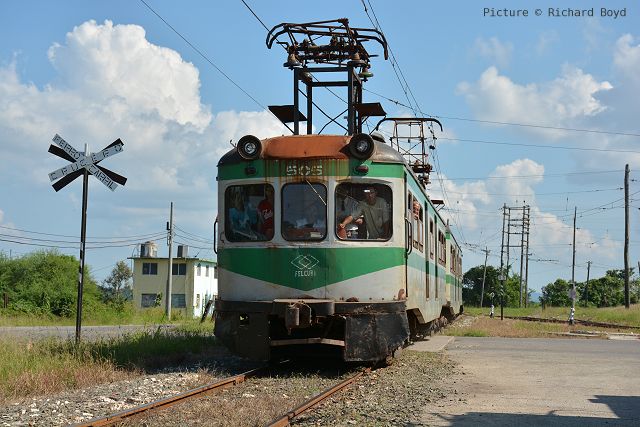
The on-going discussion about lamp brackets and overhead live wires. This has brought back memories of something that happened whilst I was on holiday in Cuba last October.
Following the advice of the Man in Seat 61 I decided to sample the Hershey Railway from Havana to Hershey, although the line continues to Matanzas. There are theoretically three trains in each direction every day, with the trains themselves being very battered EMUs.
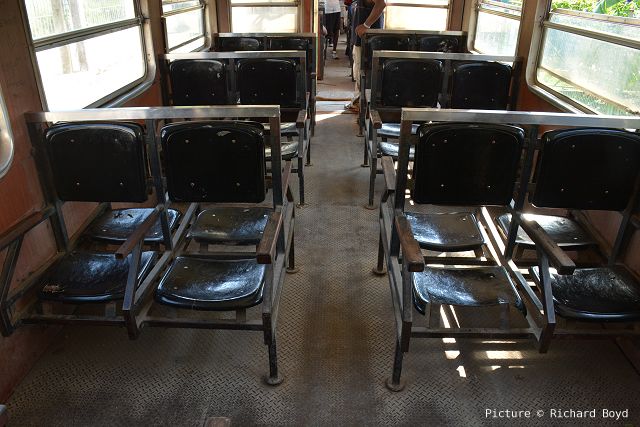
I decided to travel out from Havana to Hershey on the 12:21 departure and return on the 14:00 from Hershey. The outward journey was uneventful but for some reason which I wasn’t able to discern (English isn’t widely spoken in Cuba) the return service was delayed. However, it eventually arrived and off we went. Unbeknown to me at the time but things were about to take a bizarre twist.
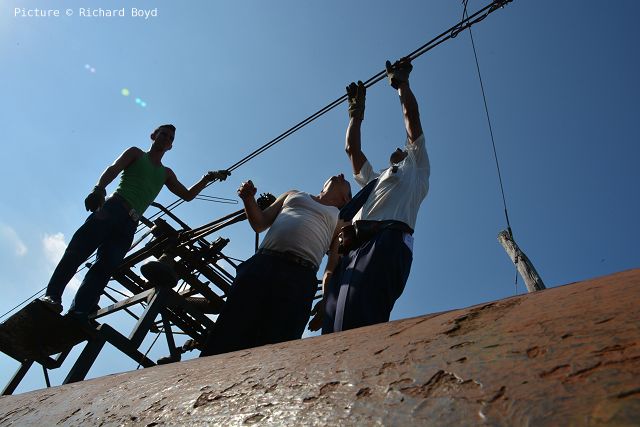
The train was about 15 minutes out of Havana when it ground to a halt and it quickly became apparent there were problems with the catenary. Consequently I sat back and awaited either a rescue loco or some kind of onward transportation by road. What then happened took my breath away because I became aware of footsteps on the roof – and this with overhead live wires. Since the sliding doors of the train were open, I looked out and saw three of the train crew repairing the catenary by hand, heaven knows how they weren’t electrocuted.
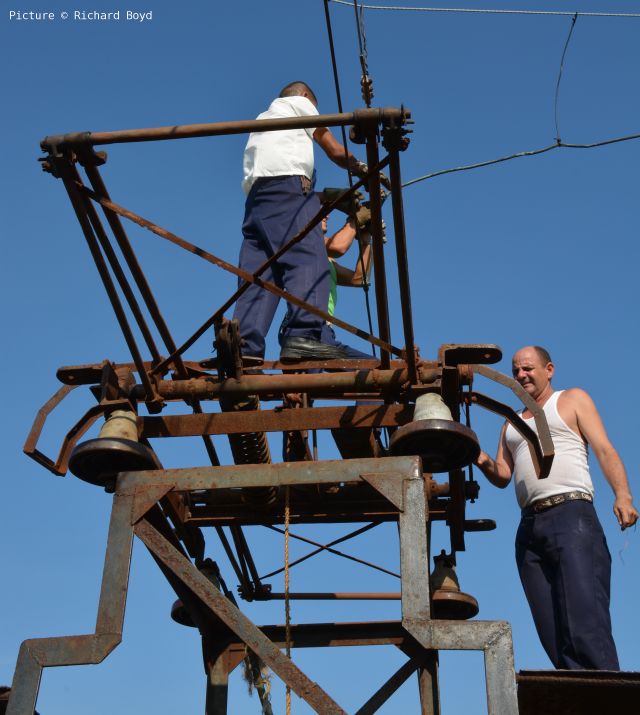
Unfortunately the makeshift repair was to no avail as the train wouldn’t restart so all three crew members returned to the roof and started wrestling with the cables again. Seeing as they hadn’t been electrocuted, I decided it would be safe to climb a few rungs of the ladder on the carriage end to take some photos. This second repair proved effective and we were able to set off about three quarters of an hour late, not that this probably mattered to any of the other passengers.
Now, can you imagine this happening on the WCML next time your Pendolino breaks own?
I would only add that Cuba is a fantastically varied country well-deserving of a visit, especially since the Americans have kissed and made up and change is inevitably in the air.
North Wales Coast home page | Archive | Previous Notice Board